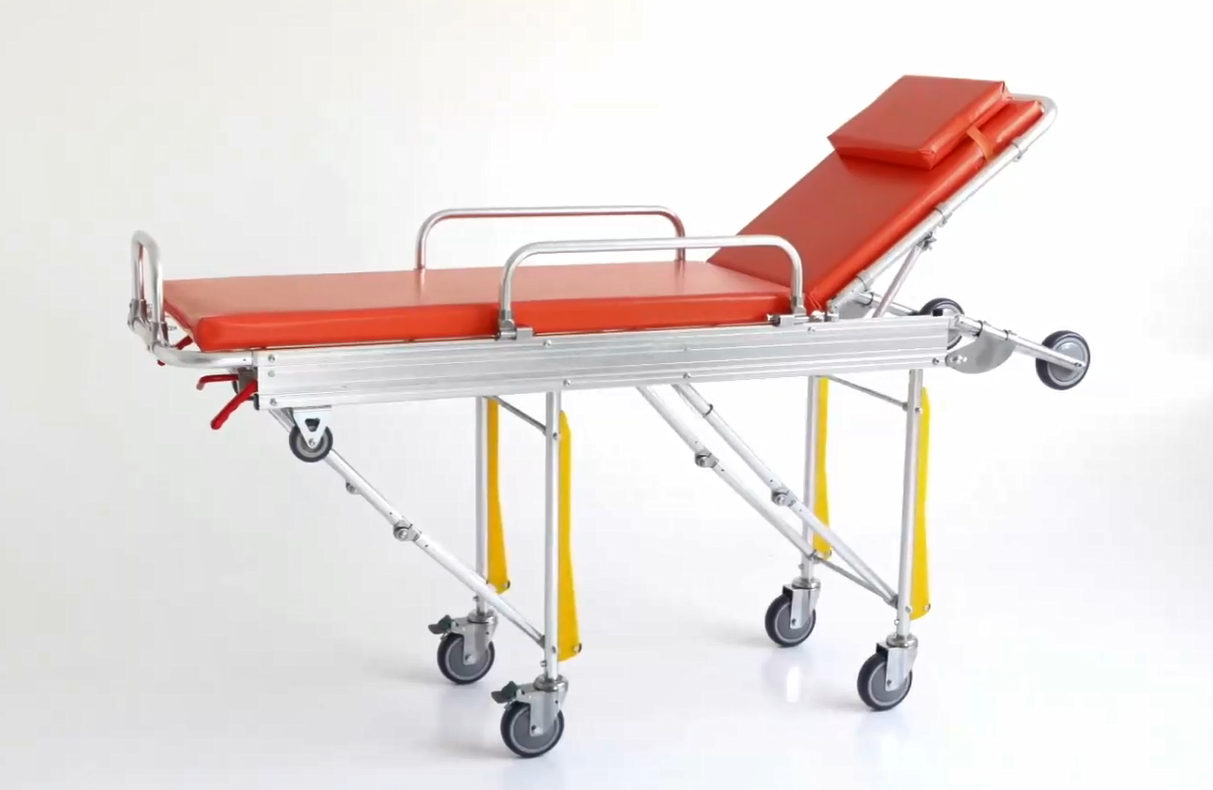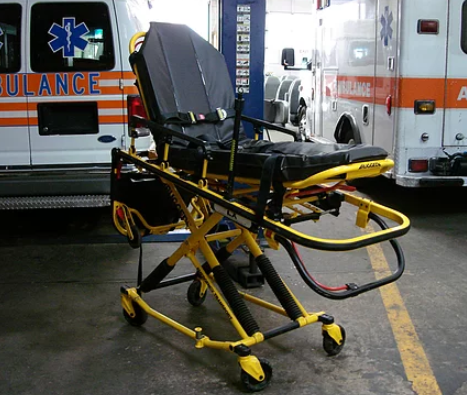Common Names for the EMS Bed
EMS beds in ambulances have different names. The name depends on your region, the situation, and the type of emergency. Here are the most common names that emergency medical professionals use:
Stretcher: Medical and emergency services accept this term most often. I recommend using this name if you want universal understanding.
Cot: EMS crews prefer this name. They use it for wheeled ambulance stretchers that have adjustable height and automatic raising/lowering features.
Gurney: This term works just like stretcher or cot. Some regions prefer “gurney” over others.
Litter: Military and technical rescue teams use this term often. It describes any device that carries a patient.
Trolley: You’ll hear this name in hospitals and UK emergency situations.

Key Types and Features of EMS Beds
Ambulance stretchers come in multiple forms. Each type serves specific scenarios:
|
Type/Name |
Primary Use |
Main Features |
Load Capacity |
|---|---|---|---|
|
Wheeled Cot (Autoloader) |
Routine ambulance transport |
Hydraulic height adjustment, wheeled, automatic operation, often includes battery-powered hydraulics |
350–700 lbs |
|
Scoop Stretcher (H-frame) |
Spinal or limb injuries |
Splits in half for immobilisation and gentle patient transfer |
350–400 lbs |
|
Spine Board (X-frame) |
Spinal immobilisation |
Rigid, flat for complete spinal support |
250–400 lbs |
|
Basket Stretcher |
Technical/mountain rescue |
Rigid frame, side protection for rugged conditions |
300–600 lbs |
|
Soft/Nylon Stretcher |
Rescue in difficult terrain |
Foldable for rapid deployment and transport |
<300 lbs |
Notable Features and Facts
Autoloader stretchers are the most common type for regular EMS transport. They come in various sizes. You can find options for bariatric patients too.
Battery-powered hydraulics on modern wheeled cots make patient lifting safer. A single EMT can lift and lower patients up to 700 lbs (317 kg). I suggest this feature for EMS teams working with limited staff.

Scoop stretchers keep patients immobile. This is vital for those with suspected spinal or leg injuries. The stretcher protects them during transport.
Basket stretchers work well in mountains or confined spaces. Teams design these for harsh environments.
All modern ambulance cots have restraints to secure patients. This is a standard safety feature.
Foldable stretcher designs store easily. They deploy fast in emergencies. Based on my experience, this feature saves critical time.
Leading EMS Bed Manufacturers
I recommend checking these recognized manufacturers of ambulance stretchers and cots:
Stryker
Hill-Rom
These brands offer various models. They meet different EMS requirements and standards. Each manufacturer has unique strengths for specific transport needs.
Regional and Professional Variations of EMS Bed Names
Different regions name ambulance beds based on local customs, language, and equipment standards. “Ambulance stretcher” is the most formal and universal term. But many regions prefer their own names based on history or how they work.
Regional Terminology Overview
United States and Canada: Most EMS crews say “stretcher,” “ambulance cot,” or “gurney.” Leading brands such as Stryker and Ferno make advanced models. These models feature wheeled, self-loading mechanisms.
United Kingdom: The typical term is “stretcher.” NHS ambulances use “ambulance trolley” for specific models. “Litter” appears in official or technical references.
Australia and New Zealand: “Ambulance stretcher” is standard across most services. In remote areas, portable folding or scoop stretchers are common for off-road emergencies.
Europe: Each country uses its own language. Germans say “Trage,” French say “brancard,” and Italians say “barella.” Equipment choices depend on terrain and ambulance type. Teams adapt for mountains or rural areas.
Asia: Urban EMS teams use both English and translated terms for “stretcher.” Local terms vary in India, China, and Japan.
Professional Names by Use Case
Folding Stretcher: I recommend this design for air ambulance and rescue teams. It stores easily and you can carry it into remote areas. Aluminum frames give the best strength-to-weight ratio. This matters for disaster response and rural transport.
Scoop Stretcher: This is critical for trauma scenes or suspected spinal injury. It splits in two. This means minimal patient movement during transfer. Adjustable sizes suit both adults and children.
Wheeled or Rigid Ambulance Stretcher: High-traffic EMS systems and urban areas need these for fast patient transfers. Shock-absorbing wheels work on uneven surfaces. Self-loading mechanisms speed up operations.
Vacuum Mattress: Advanced rescue teams in Europe prefer this option. It immobilizes patients with multiple fractures. I’ve seen this used during alpine rescues. The mattress molds around the patient. It provides rigid immobilization.
Regional choice of terms and stretcher design depends on available resources, local regulations, and typical emergency scenarios.
Key Takeaways: Essential Features and Standards of Ambulance Stretchers
Ambulance stretchers are also called “stretchers” or “ambulance cots.” They are built for safety, reliability, and efficient emergency care. Here are the core specifications and features that matter most:
Standard Specifications
Weight Capacity
Most ambulance stretchers support up to 159 kg (350 lbs). Advanced models are rated for 181 kg (400 lbs) or even higher for bariatric patients. This range ensures safe transport for a wide patient demographic.
Dimensions
Typical sizes are 190 cm (75 in) long by 56 cm (22 in) wide. This balances patient comfort with ambulance space constraints.
Example: Upright dimensions around 78 in × 23 in × 40 in. Collapsed dimensions are 78 in × 23 in × 14 in for storage.
Height Adjustability
Stretchers adjust from 36 cm (14 in) collapsed to 101 cm (40 in) upright. This reduces lifting strain. It also makes patient transfer smoother.
Construction Materials
Made of aluminum or stainless steel for strength and longevity.
Surfaces use fluid-retardant, easy-to-clean mattresses. This helps with infection control and maintenance.
Critical Safety and Comfort Features
Safety Belts and Straps: These secure patients during all phases of transport.
Side Rails: They add stability and prevent falls.
Advanced Locking Systems: Locking mechanisms keep the stretcher fixed inside the ambulance.
Patient Comfort: I recommend looking for adjustable back support (from 0 to 88 degrees). Good designs also have ample mattress space and easy operation.
Mobility and Operational Efficiency
Rugged Wheels and Foldable Legs: These enable movement across different surfaces. They also streamline loading and unloading.
Hydraulic/Mechanical Elevation: Modern models include hydraulic elevation and hand cranks. Some have convertible stretcher-chair forms for flexible use.
Standardized Dimensions: These guarantee compatibility across ambulance models. They also support uniform training for EMS personnel.
Regulatory Compliance
Stretchers are designed to meet compliance standards. These include ISO 1865 and US federal ambulance requirements (e.g., KKK-A-1822E). They establish minimum benchmarks for integration and safety.
Practical Selection Advice
I suggest choosing an EMS stretcher with the right weight capacity. Look for well-designed securing features, strong materials, and easy cleaning options.
Based on my experience, you should assess features that maximize provider safety and patient comfort. This is critical during high-stress emergency transports.
